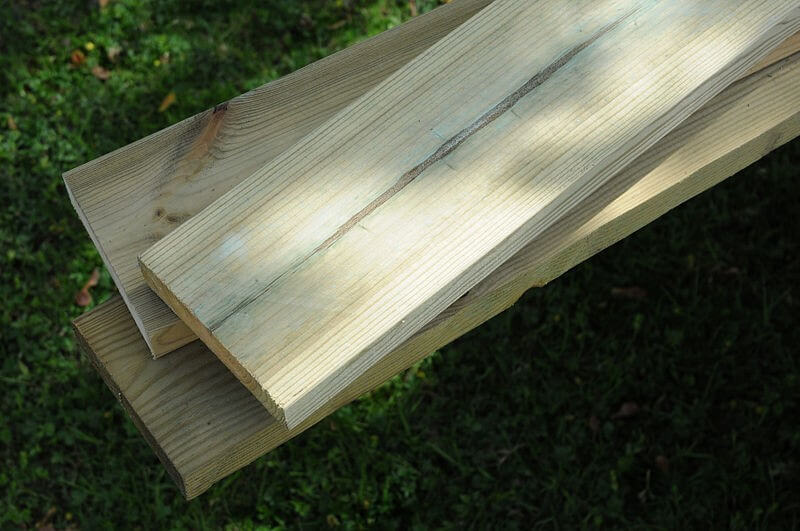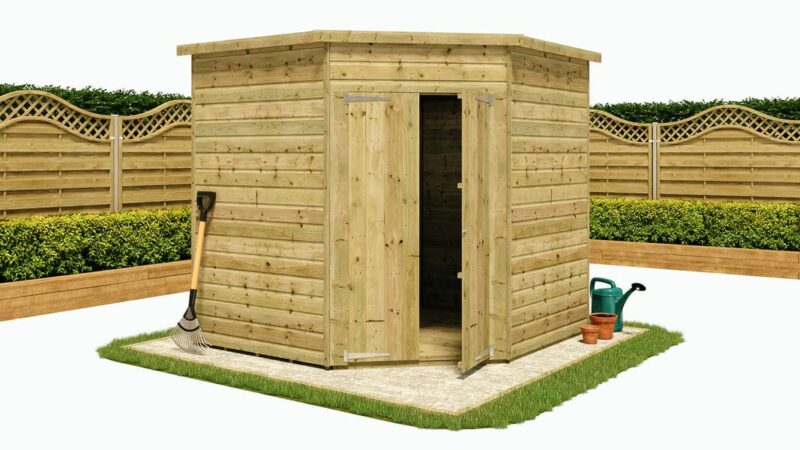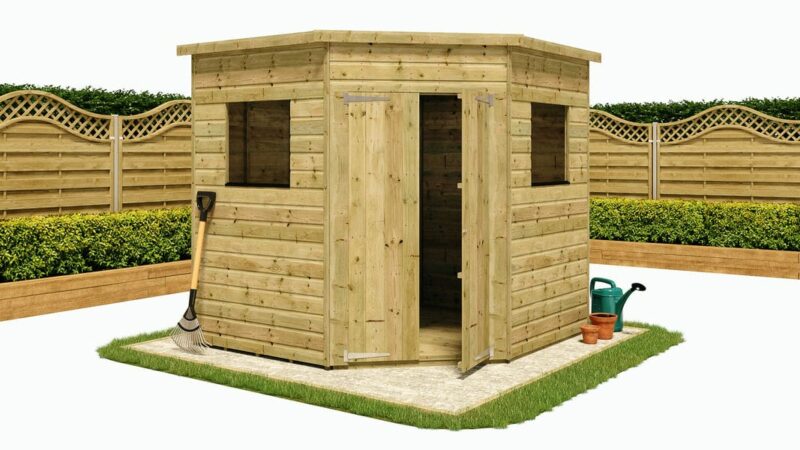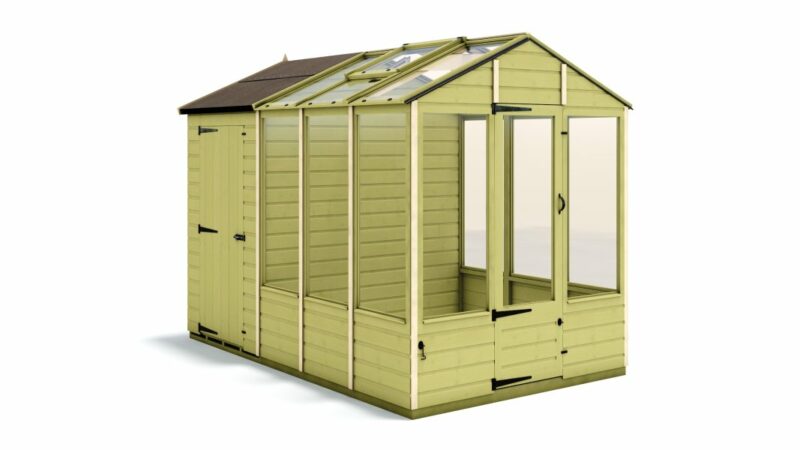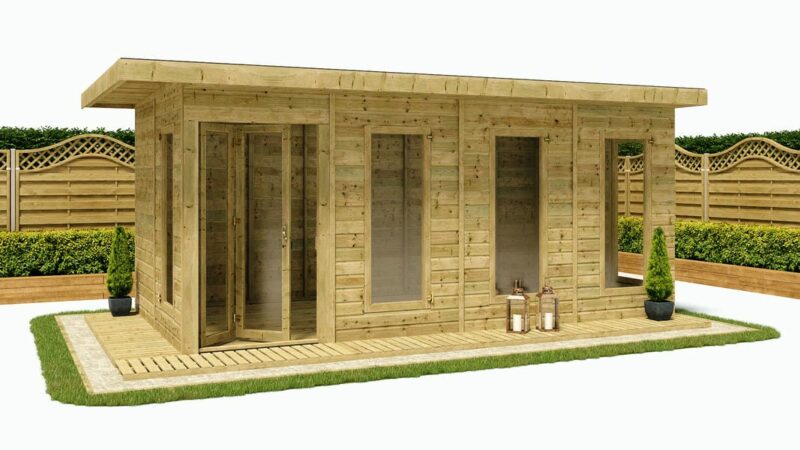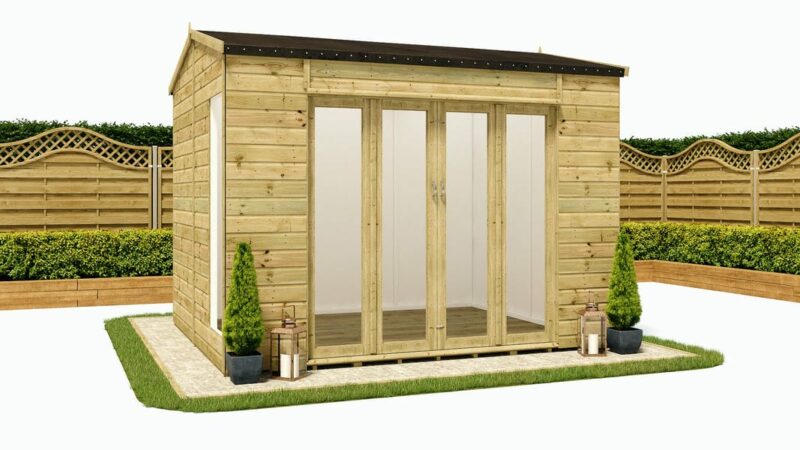So, you have a big garden project to complete, and you’re shopping online for the lumber you need to get the job done. You notice as you peruse website after website that you keep running into the same green coloured lumber.
At first, you think the green-tinged wood is just an odd paint choice, but after seeing it time and again you begin to realise that this “pressure treated wood” is more than what it appears to be on the surface.
You find pressure treated wood can be used for any number of outdoor projects: children’s playhouses, bike sheds, garden benches, beach huts, wooden sheds, traditional log cabins, play equipment and even a garden office or two.
That’s when you realise that there’s something special about pressure treated wood.
Indeed, pressure treated wood is unique. We’re going to discuss what pressure treated wood is and why it’s the superior choice for outdoor structures.

Pressure treated wood has been around for more than seven decades
That’s right. Pressure treated wood has been around for more than 70 years. Despite this fact, the general public is still mostly clueless about the benefits of pressure treated wood. In a nutshell, pressure treated wood is lumber that has been treated with a special wood preservative that’s specially designed to fight off decay, rot, and termites.
Lumber boards are pushed into a massive pressurised tank filled with special chemical preservatives which is then forced deep into the grain of the wood. Once the process is finished, you’re left with wood that’s perfect for building a number of structures such as dog kennels, log cabin garages and even wooden garden furniture.
This is also the point where you’re left with the green wood tinge finish that you’ve seen so often online.
Fun fact
The most common type of treated wood is southern yellow pine.
Now, keep in mind that not all wood receives the same amount of protection after pressure treatment. Frankly, the level of rot and decay resistance is directly correlated to how much wood preservative is used during the treatment process. A light treatment will call for weaker protection and vice versa.
When building with lumber, there are a number of factors you should keep in mind. Not all wood is created equal. Wood that’s labelled “Above Ground Use” should only be used in projects where it won’t contact the earth. Lumber that is labelled “Ground Contact” can be placed on the ground. For example, laying a wooden foundation for a log cabin.
With this in mind, the success of your project is often contingent on whether or not you use the right type of lumber. You can confirm this by examining the chemical retention level of the lumber board by looking at the stamp that should be located somewhere on the body of the wood.
Chemical retention
The chemical retention number indicates the minimum amount of wood preservative that has been injected into the lumber. This number is represented by pounds of wood preservative per cubic foot. As you might have guessed, the higher the number, the better its ability to resist rot.
It can be confusing ascertaining the actual chemical retention of pressure treated wood, even in the lumber industry. There are often changes that even seasoned professionals have problems keeping up with.
The source of the confusion can be traced to the wood preservative chromated copper arsenate (CCA). CCA has a proven track record over seven decades old of being an effective chemical for treating wood. The use of CCA can be tracked all the way back to the mid-1940s.
Trouble began to arise when public health concerns became an issue. Thus the chemical was banned from residential projects in 2003. Despite this, CCA has proven so effective that it’s still used for docks, boardwalks, and large-scale commercial projects amongst other projects.
CCA was so popular that its chemical retention levels practically became the industry standard. CCA retention levels were .40 for wood suited for ground contact and .25 for wood suited only for above ground use.
Now that CCA has been largely restricted, retention levels vary depending on the wood preservative used to treat the lumber. Keep in mind that each wood preservative may have a different retention level. For example, micronized copper azole, has a retention level of .15 for wood suited for ground contact and .06 retention for wood only suitable for above ground contact.
One misconception people commonly have is that lower retention levels translate to a less durable product. That’s simply not the case. All wood preservatives are effective. However, they may interact with the wood differently due to their unique properties.
The concept is certainly confusing, but rest assured that the professionals who pressure treat wood for a living know exactly what they’re doing.
Safety measures have tightened since the ban of chromated copper arsenate. As a result, a wider range of inorganic chemicals is used to treat wood in today’s lumber industry.
Other commonly used chemicals are Micronized Copper Quaternary (MCQ), Sodium Borate (SBX), Copper Azole (CA) and Alkaline Copper Quaternary (ACQ). These chemicals are used because they’re less toxic than CCA, but this comes at a cost. Each chemical is more corrosive than CCA treated lumber because they contain higher levels of copper.
Lumber companies have had no choice but to accept the tradeoff. Due to the corrosive nature of copper it’s primarily recommend that you only use hot-dipped or stainless steel anchors, connectors, galvanized nails and screws.
Aluminum is also susceptible to the corrosive nature of copper. Therefore using copper or vinyl flashing is recommended. You can also wrap the wood in rubber to achieve the same levels of protection.
Where to use pressure treated wood
Though pressure treated wood seems like a natural choice for any home project, its application should only be used in outdoor environments. Wood used for indoor projects should be left in its natural state.
The sawdust from pressure treated wood can irritate the eyes, nose, and skin. Further issues could occur if the chemical preservatives were to leak into your wooden floorboards.
Though pressure treated wood isn’t suitable for indoor use, selecting the proper wood species should sufficiently fend off any rot or insects that you would typically deal with in an indoor environment.
Tips when working with pressure-treated lumber
Though it’s tempting to treat pressure treated wood like any other average piece of lumber the reality of the situation is that the wood is filled with chemicals and should be handled with care. Here are a few tips when working with pressure treated wood.
- Never burn pressure treated wood.
- Wearing a dust mask and safety goggles should always be required when sanding, drilling or cutting pressure treated wood.
- Pressure treated wood will dry out over time. During this period it will shrink across its width somewhat. This shrinkage should be considered when laying fence boards or decking.
- Pressure treated wood will develop cracks called “checks” after being outdoors anywhere from 6 to 12 months. These cracks occur during the drying process and are completely normal.
- Though pressure treated wood is low maintenance, it doesn’t hurt to apply clear wood preservative on a yearly basis to strengthen its ability to resist water damage. This should only be done if you decide not to paint or stain the wood.
- Always wear gloves when working with pressure treated wood.
- Wash your hands thoroughly after handling treated wood.
- Never cut treated wood indoors.
- Before painting or staining pressure treated wood, you should allow it to dry. Testing dryness is a simple affair.
Sprinkle a few drops of water onto the surface of the wood. If the water takes on a bead-like form, then it still needs more time to dry. If it absorbs into the wood, then it’s ready to go.
Pressure treated wood is the superior choice for outdoor use. The special preservatives injected into the lumber will ensure that your outdoor projects will last for decades to come. With low maintenance and a proven track record of effectiveness pressure treated wood is well worth the investment.



